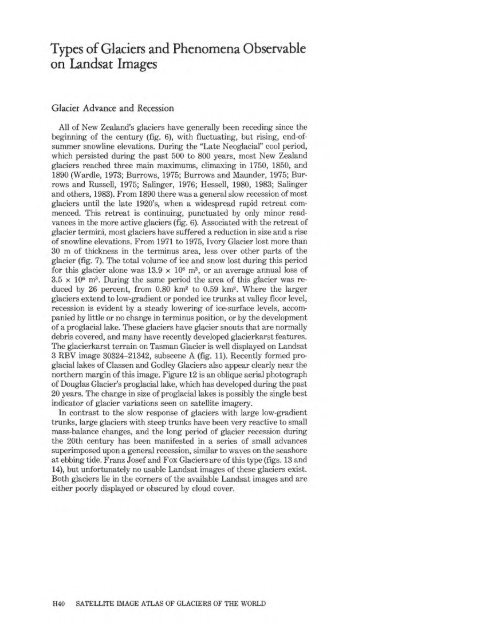IRIAN JAYA, INDONESIA, and NEW ZEALAND
IRIAN JAYA, INDONESIA, and NEW ZEALAND
IRIAN JAYA, INDONESIA, and NEW ZEALAND
You also want an ePaper? Increase the reach of your titles
YUMPU automatically turns print PDFs into web optimized ePapers that Google loves.
Types of Glaciers <strong>and</strong> Phenomena Observable<br />
on L<strong>and</strong>sat Images<br />
Glacier Advance <strong>and</strong> Recession<br />
All of New Zeal<strong>and</strong>'s glaciers have generally been receding since the<br />
beginning of the century (fig. 6), with fluctuating, but rising, end-of-<br />
summer snowline elevations. During the "Late Neoglacial" cool period,<br />
which persisted during the past 500 to 800 years, most New Zeal<strong>and</strong><br />
glaciers reached three main maximums, climaxing in 1750, 1850, <strong>and</strong><br />
1890 (Wardle, 1973; Burrows, 1975; Burrows <strong>and</strong> Maunder, 1975; Bur<br />
rows <strong>and</strong> Russell, 1975; Salinger, 1976; Hessell, 1980, 1983; Salinger<br />
<strong>and</strong> others, 1983). From 1890 there was a general slow recession of most<br />
glaciers until the late 1920's, when a widespread rapid retreat com<br />
menced. This retreat is continuing, punctuated by only minor read-<br />
vances in the more active glaciers (fig. 6). Associated with the retreat of<br />
glacier termini, most glaciers have suffered a reduction in size <strong>and</strong> a rise<br />
of snowline elevations. From 1971 to 1975, Ivory Glacier lost more than<br />
30 m of thickness in the terminus area, less over other parts of the<br />
glacier (fig. 7). The total volume of ice <strong>and</strong> snow lost during this period<br />
for this glacier alone was 13.9 x 106 m3 , or an average annual loss of<br />
3.5 x 106 m3 . During the same period the area of this glacier was re<br />
duced by 26 percent, from 0.80 km2 to 0.59 km2 . Where the larger<br />
glaciers extend to low-gradient or ponded ice trunks at valley floor level,<br />
recession is evident by a steady lowering of ice-surface levels, accom<br />
panied by little or no change in terminus position, or by the development<br />
of a proglacial lake. These glaciers have glacier snouts that are normally<br />
debris covered, <strong>and</strong> many have recently developed glacierkarst features.<br />
The glacierkarst terrain on Tasman Glacier is well displayed on L<strong>and</strong>sat<br />
3 RBV image 30324-21342, subscene A (fig. 11). Recently formed pro-<br />
glacial lakes of Classen <strong>and</strong> Godley Glaciers also appear clearly near the<br />
northern margin of this image. Figure 12 is an oblique aerial photograph<br />
of Douglas Glacier's proglacial lake, which has developed during the past<br />
20 years. The change in size of proglacial lakes is possibly the single best<br />
indicator of glacier variations seen on satellite imagery.<br />
In contrast to the slow response of glaciers with large low-gradient<br />
trunks, large glaciers with steep trunks have been very reactive to small<br />
mass-balance changes, <strong>and</strong> the long period of glacier recession during<br />
the 20th century has been manifested in a series of small advances<br />
superimposed upon a general recession, similar to waves on the seashore<br />
at ebbing tide. Franz Josef <strong>and</strong> Fox Glaciers are of this type (figs. 13 <strong>and</strong><br />
14), but unfortunately no usable L<strong>and</strong>sat images of these glaciers exist.<br />
Both glaciers lie in the corners of the available L<strong>and</strong>sat images <strong>and</strong> are<br />
either poorly displayed or obscured by cloud cover.<br />
H40 SATELLITE IMAGE ATLAS OF GLACIERS OF THE WORLD

















